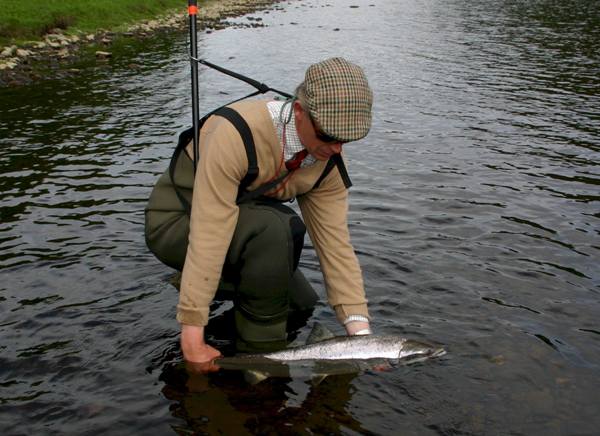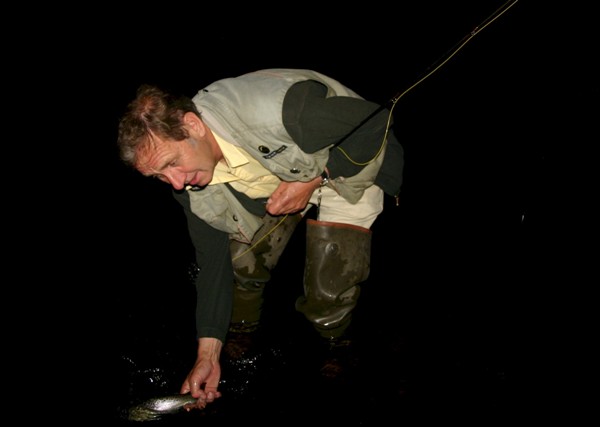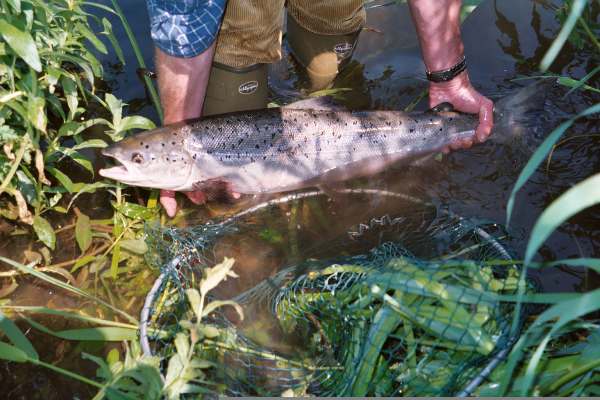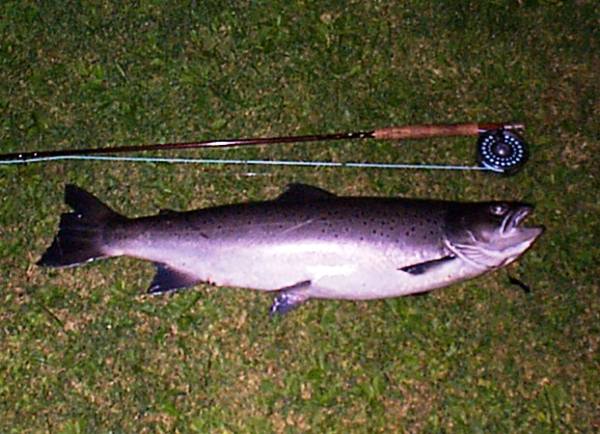Trees Birds Mammals Fish Amphibians Reptiles
Wild Algarve
Bookshop
Catch and Release Guide
Benefits - Guidelines - Length-weight Converter
Why bother?
Stocks of wild fish are seriously depleted, and if we want future generations of anglers to enjoy fishing for wild trout, sea trout and salmon it is essential that we return as many fish as possible to the rivers so that they can continue to live to produce future generations of fish. (And if you really want to know the weight of a fish, measuring its length and using our length-to-weight converter will give you a pretty good estimate.)
Best Practice Guidelines
Most anglers wouldn't even consider killing a wild brown trout these days, but worrying numbers of wild salmon and sea trout are still killed and taken home for the pot every year. Below is a guide to the legal requirements for releasing fish and also how best to play and land a fish so that it is in the best possible shape to be returned to the river in order to survive and spawn.
Below: Mike Evans demonstrates the right way to release a salmon

Releasing at least some of the salmon that you catch is not an optional decision to be based upon personal preference or conscience: it is a legal requirement. If you catch salmon parr, smolts or adult salmon below a specified size – and in some places above a certain size – you must release them with the minimum of delay. Kelts, baggots, and ‘coloured’ fish that are close to spawning must also be returned to the river. (Coloured salmon may well be spring-run fish that have spent several months in the river, and the early-running multi-sea-winter component of salmon stocks has suffered most severely from reduced survival during their time out at sea. Releasing these salmon to spawn is particularly important, therefore, for the future of the river.) Some fisheries have a rule that the first salmon you catch on any day must be returned, and since 1999 throughout England and Wales it has been a statutory requirement that all salmon caught by anglers before 16th June must also be released.
Below: Pat O'Reilly releases a Sea Trout at night

The depleted state of wild Atlantic salmon stocks has also prompted an increase in what is called ‘voluntary catch and release’. For example on most of the southern English chalk rivers nowadays pretty well every salmon that is caught is released in an effort to increase the spawning stock and so help restore the salmon fishery in future. The main problem may not be angling exploitation, but anglers can avoid making things worse: there is incontrovertible evidence that a salmon killed and taken home by an angler cannot spawn.
Does catch and release achieve anything? Do salmon that are caught by flyfishers and then released survive to spawn? The survival rate depends upon water temperature and on how the salmon are handled. Not surprisingly, salmon caught when the water is very warm and low in dissolved oxygen can cope with less stress than fish caught when the water is cold. Research shows that if the tackle used is strong enough to allow salmon to be brought in quickly rather than being played to exhaustion, and if the fish are handled correctly during unhooking and released without undue delay, around 85 per cent of spring salmon will survive to spawn, and an even higher proportion can be expected of autumn fish. Given that while in the river some 15 per cent of salmon can be expected to die of natural causes (predation, disease or injuries suffered when leaping rocky waterfalls, for example) the inference is that angling losses can usually be reduced to an insignificant level.
Below: A lovely hen salmon is released in the Hampshire Avon

These simple guidelines can help ensure that the salmon you release stand maximum chance of surviving to spawn and so help rebuild stocks for the future:
Fish with single hooks, either barbless or with the barbs squeezed down
Use tackle strong enough to subdue the fish quickly
If possible, keep the salmon in the water while unhooking it
If a photograph is being taken, hold the fish horizontally, not vertically by the tail
Don’t waste time weighing a fish; measure its length against your fishing rod
Hold the fish in the current with its head upstream until it is ready to swim away
Top of page...
Length to Weight Converter
It's great to return wild trout, salmon and pike so that they can survive and add to the spawning stock, but it's also nice to know how big your catch is, and in the UK at least it has been the tradition to record weight rather than length. Now there is no need to put a fish through extra stress and delay involved in weighing it, because you can get a pretty good estimate of the weight of a trout, salmon or pike from its measured length.
The formulae used in the calculator below is:
Trout and Salmon Weight (in pounds) = (Length x Girth x Girth)/800 where Length and Girth are expressed in inches.
Pike Weight (in pounds) = (Length x Girth x Girth)/900 where Length and Girth are expressed in inches.

If you have recorded only the length measurement, the calculator will automatically insert the typical girth measurement (58% of the length) expected for a fish of that size. (Hen fish tend to have bigger girth measurements than cock fish of the same length; also, lake trout are often deeper-bodied than river trout, so measuring girth is definitely worthwhile if you need an accurate result).
No tape measure? No problem! Length can be recorded against a position (relative to the top of the butt cork or to one of the rod rings, for example, as we did with the 11.5lb sea trout shown here). Make a mental or written note - 'two inches above the butt ring', for example - so that it can be checked with a tape measure when you get back home.
For estimating the weight of a sea trout or a salmon, just use the 'Trout' calculator - it still gives you a pretty accurate estimate of the weight.
Top of page...
Excited by rivers and streams? So are we, and we're pretty sure you would find the Winding River Mystery trilogy of action-packed thrillers gripping reading too. Dead Drift, Dead Cert, and Dead End are Pat O'Reilly's latest river-based novels, and now they are available in ebook format. Full details on our website here...
Buy each volume in ebook format for only £2.47 on Amazon... Paperbacks also available on Amazon at £6.95 each. All proceeds go towards keeping the First Nature website online.
Please Help Us: If you have found this information interesting and useful, please consider helping to keep First Nature online by making a small donation towards the web hosting and internet costs.
Any donations over and above the essential running costs will help support the conservation work of Plantlife, the Rivers Trust and charitable botanic gardens - as do author royalties and publisher proceeds from books by Pat and Sue.